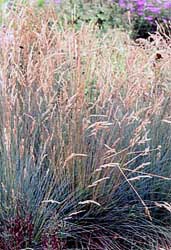 Grasses are perhaps the most important plant family of all to mankind
Grasses are perhaps the most important plant family of all to mankind.
They provide us with important cereal crops, food for grazing animals, playing surfaces for most of our sports, fresh and dried cut flowers, culinary and perfumery herbs, and are extremely important for building and other construction (ie. Bamboos); particularly across the tropics.
True Grasses belong to the family Poaceae (syn. Gramineae)
Other plants such as reeds and rushes may occasionally be called “grasses” by non technical people, but they are not really grasses.
Landscapers and gardeners use grasses as ornamental plants in garden beds, containers, vertical and roof gardens and other places.
Grasses and grass like plants create a very different visual affect to the type of garden we are so often used to seeing. A garden that is dominated by fine long leaves can create a “gentler” and more “relaxed” mood.
The affect of long arched leaves blowing in the wind can be even mesmerizing.
The Japanese identified this characteristic in grasses a very long timer ago; and have used bamboos widely in their gardens to create a mood of serenity.
Grasses are Diverse
Grasses are one of the largest families of flowering plants. They range in size from tiny creeping or clumping species through to magnificent tropical bamboos. There are many other different features:
- Various foliage colours…red, blue, green and even gold tones
- Thick and thin leaves
- Upright and drooping foliage
- Tall and low flower spikes
- Different coloured flowers
- Some are invasive; some are not
- Some grow in very wet soil; some in dry
Ways to use Grasses In a Garden
Grasses can be used for much more than just lawn:
- Plant a whole garden or section f a garden with nothing but grasses
- In pots/tubs as a specimen
- As a border or hedge to contrast with plants behind
- In the gaps between paving stones
- In narrow garden beds
- With broad-leaved plants as part of a mixed garden bed
- To attract seed eating birds
Article adapted from our ebook on Grasses -available on this web site